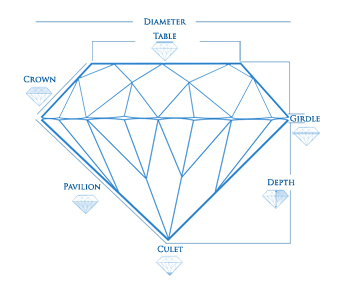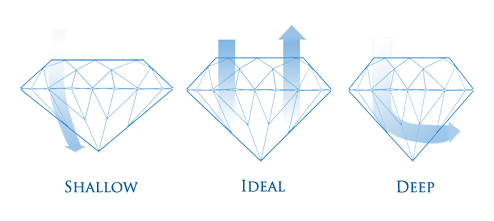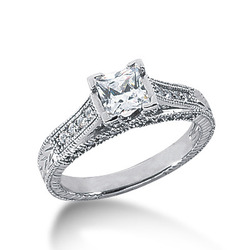Diamond Cut
What to Look For In a Good Diamond Cut
Cut is one of the 4Cs of a diamond, and arguably the most important one. Why? Because it affects the sparkle of the diamond directly. When the light goes through a diamond, it’s ideal that it gets reflected back. If the diamond is too shallow, light can escape underneath. If it’s too deep, light can spread out too much, which is also not ideal. As Cut grade goes up, more light gets reflected with a brilliant sparkle from the diamond surface.
Cut is not simply the symmetry of the diamond but also crafting of facets. Proportions, cutting precision and details of finish, along with other physical aspects of the finalized stone, determine the final Cut grade of the diamond. It’s also important to note that most diamond grading institutions, such as GIA, grade only round shape diamonds for Cut. Cut grade for fancy shape diamonds can also be determined, however there is no internationally accepted system for visually evaluating the appearance of fancy-cut diamonds at this time.
Diamond Anatomy
To understand some of the finer points of diamond cuts, it's necessary to first understand some basic diamond vocabulary.

Diameter: The width of the diamond through the girdle.
Table: The largest facet of the diamond at the top.
Girdle: The intersection of the crown and the pavilion. It’s the circumference of the diamond.
Crown: The top portion of the diamond that ends at girdle.
Pavilion: The bottom portion of the diamond that ends at culet.
Culet: The tiniest facet at the very bottom of the diamond.
Depth: Measurement of the diamond from table to culet.
Let the Light Shine Through
Every diamond has its own, unique proportions which directly affect the way light travels through the diamond and is reflected back up through the table. This, in turn, influences the sparkle, or brilliance of the diamond and its perceived beauty. In fact, the cut of a diamond, far more than its color or clarity, affects its splendor.
If a diamond is cut too shallow, light can escape from underneath, reducing the brilliance. If the cut is too deep, light can spread out from the sides, again affecting the sparkle. A diamond with good proportions will allow the light to travel inside the diamond, reflecting the light through the table and crown for maximum sparkle.

The sparks or small flashes of light often seen as a diamond moves are otherwise known as scintillation. As well as brilliance, which is essentially the amount of white light reflected by the diamond, the cut also influences the amount of fire and scintillation of the diamond. The fire is the way the light is refracted by the diamond, splitting it into the beautiful colors of the rainbow.
Diamond Cut Grades
Excellent Cut (E): The highest Cut grade. It reflects the most light and shows the most sparkle.
Very Good Cut (VG): Close to excellent cut in sparkle, this is a great choice at a slightly lower cost.
Good Cut (G): Significant amount of sparkle. If the final cost is important for you, a good cut diamond will offer you substantial value.
Fair Cut (F): Decent amount of sparkle and brilliance. You can find good carat weight and size options for a budget with fair cut grade.
* Diamonds which have a GIA or IGI Report are graded according to the scale of those organizations.

